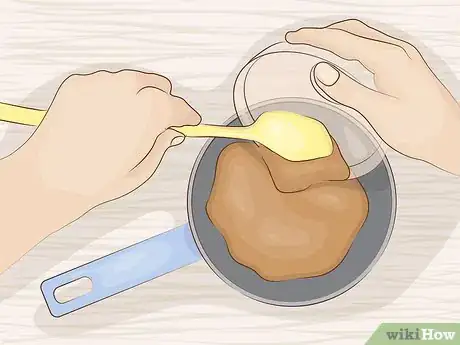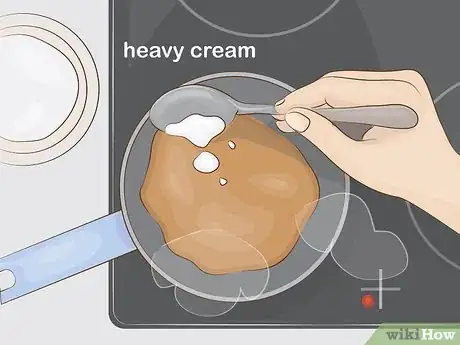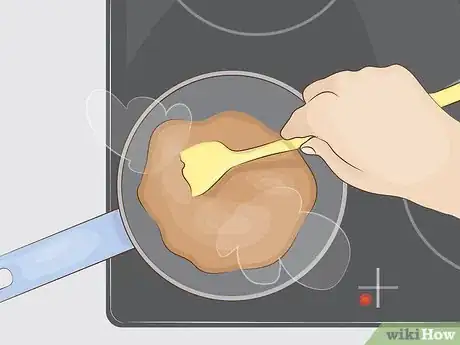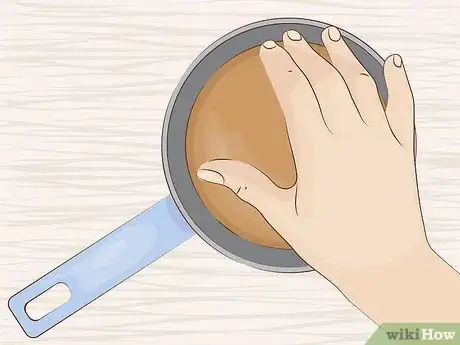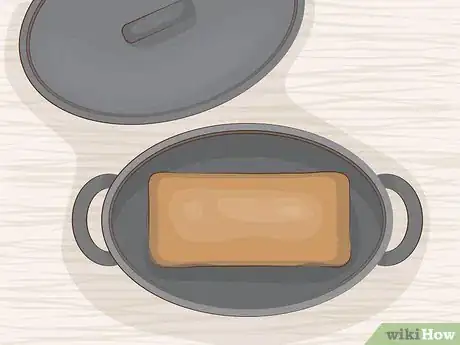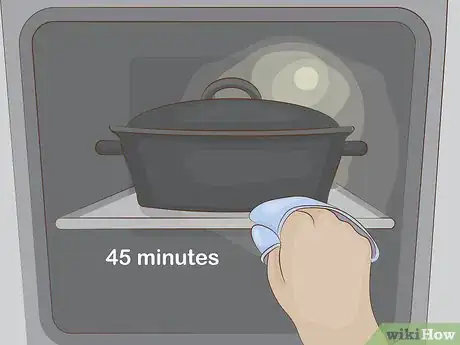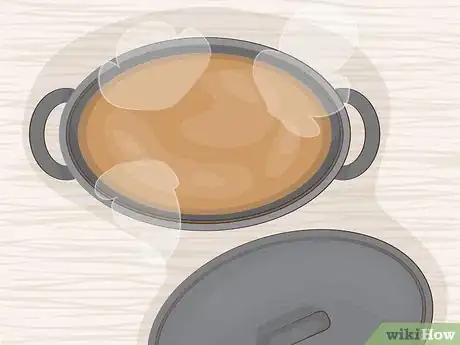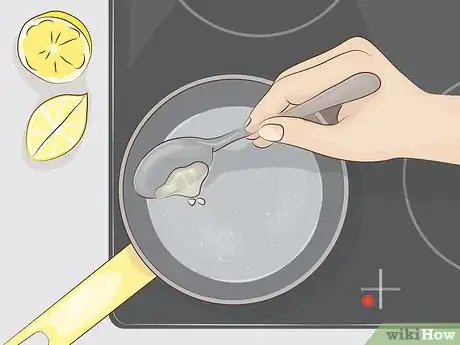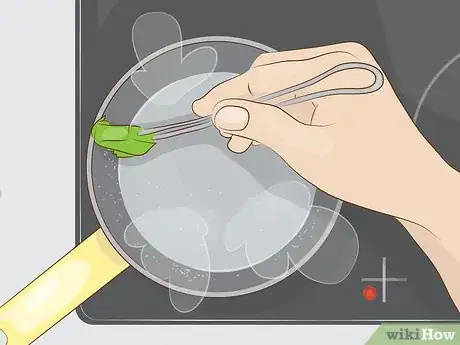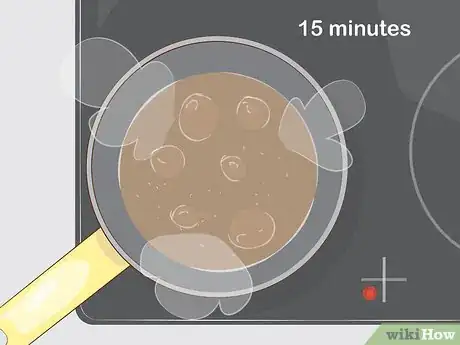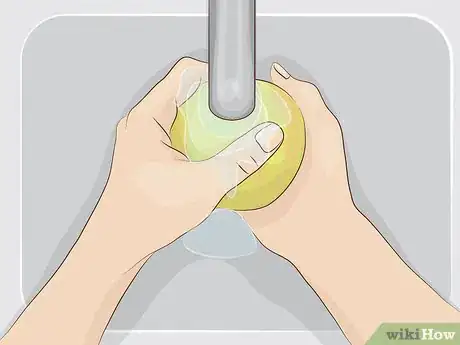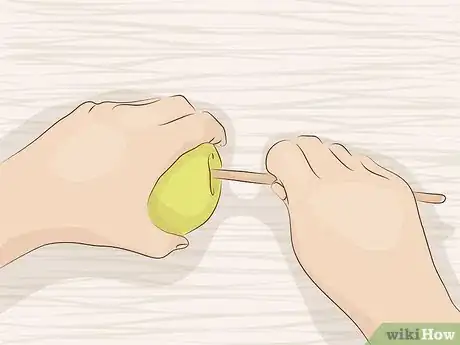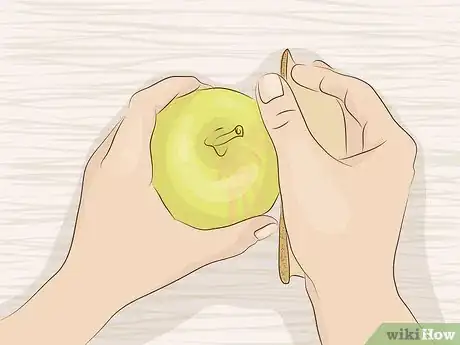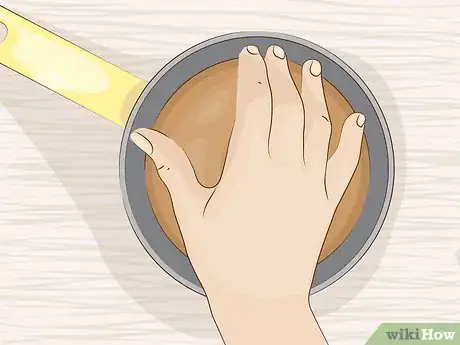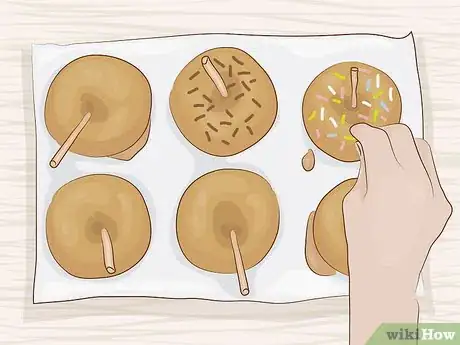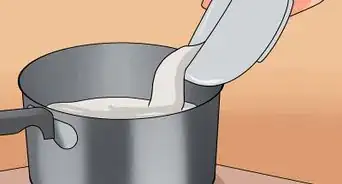This article was co-authored by wikiHow Staff. Our trained team of editors and researchers validate articles for accuracy and comprehensiveness. wikiHow's Content Management Team carefully monitors the work from our editorial staff to ensure that each article is backed by trusted research and meets our high quality standards.
There are 13 references cited in this article, which can be found at the bottom of the page.
This article has been viewed 87,047 times.
Learn more...
Caramel is a deliciously sweet sauce that can turn up the volume on any dessert it’s added to. But if you’re hoping to drizzle caramel over vanilla ice cream or getting ready to dip apples for a fall celebration, you need a sauce that’s not too thick. To thin caramel, just add some cream or water over heat. Melt caramel loaves in the oven. You can also add corn syrup or lemon juice to caramel sauces to prevent them from crystallizing. It’s also a good idea to know how to make caramel in the first place! Finally, learn a few tricks to make your thinned-out caramel really stick to your apples.
Steps
Thinning Caramel with Liquid
-
1Transfer your caramel to a saucepan. A medium-sized, nonstick saucepan works best. Use a nonstick spatula to scrape all the sauce into the pot.[1]
-
2Turn your stovetop burner on low heat. You don’t need the caramel to be extremely hot in order to thin it. In fact, adding too much heat could actually burn the sauce! Allow the caramel to warm up over low heat for just a few minutes. Stir the caramel with a nonstick spatula constantly to ensure that it’s not sticking to the bottom of the pan.[2]Advertisement
-
3Add one tablespoon (14.8 mL) of heavy cream or milk. Heavy cream is best, as it’ll preserve the flavor and consistency of your caramel sauce. Start with one tablespoon (14.8 mL), and then add more in ½-tablespoon (7.4-mL) increments if you need the sauce to be thinner.[3]
-
4Use water if your caramel sauce contains butter. There’s a small possibility that adding more cream to your caramel sauce could cause the mixture to separate. This occurs when the sauce becomes oversaturated with fat. Even if your recipe called for butter, this shouldn’t happen if you reheat the caramel slowly and stir so it heats evenly. However, if you’d like to be safe, go with water![4]
- Be aware that water may dilute the flavor of the sauce.[5]
-
5Stir until the liquid is mixed in. Mix in the liquid with your nonstick spatula. Keep the caramel on the heat (stirring constantly) until the sauce becomes one solid color again.[6]
-
6Allow the caramel to cool again before eating it. Hot caramel is dangerous! To avoid burning your tongue, wait at least five minutes and up to a half-hour to let it cool.[7]
- To test if the caramel is cool enough, put your hand just above the sauce. If it’s still giving off heat but doesn’t immediately make your hand feel steamy, you’re good to go!
Melting Caramel Loaves
-
1
-
2Place your caramel loaf in a dutch oven. Dutch ovens (also known as french ovens) are large, lidded cooking pots that can be safely put inside your oven. You do not need to grease the bottom of the pot. If you’re melting a whole caramel loaf, you may need to cut it in half or bend it to make it fit in the pot. Finally, put the lid back on and pop the pot into the oven.[10]
- Try to lay the caramel evenly in one layer. You shouldn’t need to stack pieces of caramel on top of each other.
-
3Cook the loaf for 45 minutes before checking it. Your loaf could take up to two hours to melt completely. However, it’s a good idea to check on its progress. If your oven runs hot, or if you’re melting a small loaf, it may be good to go a little early![11]
- You’ll know that the caramel is ready when it’s fully melted and is easy to stir.
-
4
-
5Allow your melted caramel to cool. Give the caramel sauce about five to ten minutes to rest before you use it. Once it’s cooled off a bit, it’s ready for you to enjoy!
Making Caramel That Stays Runny
-
1Gather and measure out your ingredients. Since caramel sauce can be temperamental and burn quickly, get your ingredients ready to add before you start cooking. To make about 1 3⁄4 cups (410 mL) of caramel sauce, you’ll need:[14]
- 1 1⁄2 cups (350 mL) granulated sugar.
- 1⁄2 cup (120 mL) water.
- 1 cup (240 mL) heavy cream.
- A medium nonstick saucepan.
- A wooden spoon or nonstick rubber spatula.
- A pastry brush that’s been dipped in a cup of water.
-
2Whisk sugar into the water in your medium saucepan. Turn your stovetop burner to medium heat. Add the sugar and water and mix them until there are no sugar clumps in the mixture. Keep the solution on medium heat until the sugar has dissolved into the water, leaving you with a clear liquid. This should happen after two to three minutes.[15]
-
3Add corn syrup, honey, or lemon juice to keep the sauce thin. You’ll need about 1 tablespoon (14.8 mL) of corn syrup or honey for every cup (236.6 mL) of caramel sauce your recipe makes. These ingredients may slow the hardening of your caramel when it's complete.
- Use lemon juice instead if you don’t mind the citrus taste. Use ½ tablespoon (7.4 mL) of lemon juice per cup (236.6 mL) of sauce. Add the lemon juice after you’ve dissolved the sugar into the water. Stir in the lemon juice and then stop stirring the mixture completely.
- The lemon juice should prevent your caramel from crystallizing, but it may alter the taste of your caramel. If you like a little bite, however, go for this option!
-
4Use a wet pastry brush to brush the sides of the pan. Turn the heat up to medium-high. Use your dampened pastry brush to get all the excess sugar-water mixture off the sides of your saucepan. This should prevent little bits of sugar from forming crystals on the edges of your sauce.[16]
-
5Cook the mixture for fifteen minutes without stirring. Keep the heat at medium-high. Stirring can prevent the mixture from cooking correctly, so just be patient and wait. Don’t walk away from the stove, though! You need to remove the pan from the heat at just the right moment to keep it from burning.[17]
-
6Remove the mixture from heat when it becomes medium tan in color. When you see the bubbles your caramel has been forming get bigger and slower, it’s probably just about ready. It should then turn color. Move the saucepan off the heat as soon as you observe this light brown shade.[18]
-
7Add heavy cream slowly once the mixture becomes dark tan. The caramel will darken a bit as it cools. Pour in about a spoonful of cream as soon as it turns into that darker shade of brown. Be careful and stand back a bit from the stove as the caramel will being sputtering up when you add the cream. Use your nonstick spatula to gently stir in the cream.[19]
- It shouldn’t take more than a minute or so for the caramel to darken.
- If the caramel seems too dark (if it’s dark brown or black) or smells burnt, you’ll need to start over. Burnt caramel sauce is not a treat you want to eat!
-
8Continue adding cream, waiting for sputtering to stop each time. Use a spoon to add the remaining heavy cream in small increments. Stir in each round of added cream with your nonstick spatula. Once you’ve added all the cream, your caramel sauce is complete![20]
-
9Allow the caramel to cool to room temperature. Give the caramel at least five minutes and up to a half-hour to cool down. When you think it’s cool, hover your hand above the sauce to see if it feels ready to eat. If the caramel makes your hand feel hot right away, it still needs more time to cool off.[21]
Putting Caramel on Apples
-
1Keep your apples in the fridge for thirty minutes before dipping. While you can leave your apples in the fridge for longer, try for a minimum of a half-hour. Using cold apples will allow the caramel to start setting as soon as you begin dipping! This should help keep the caramel sauce from sliding off the apples.[22]
-
2Wash and dry your apples. Rinse off the apples with cool water, rubbing the surfaces of the apples with your fingers to remove any dirt and/or chemicals. Then use paper towels or clean dishcloths to completely dry the fruits. Any water residue could prevent the caramel sauce from sticking correctly.[23]
-
3Remove the stems and poke popsicle sticks into your apples. Make sure you really get the sticks in there. You don’t want the apples to fall off your sticks while you’re trying to dip them in the caramel! Shake them around a bit to test that the sticks are securely in there.[24]
-
4Sand your apples lightly with fine-grit sandpaper. Use a grit of between 120 and 220 and rub the sandpaper lightly over the surface of the apples. Don’t rub so hard that you remove any of the skin. You just want to remove the wax coating.[25]
-
5Make sure the caramel has cooled before you start dipping. It’s best to use warmed-up caramel sauce for dipping. However, once it’s completely heated, be sure that it cools for at least five minutes before you dip. If your sauce is too hot, it might be more likely to slide off the apples.[26]
- You can leave the caramel in the saucepan while you dip the apples.
-
6Dip the apples and scoop caramel onto them. Stick the apple into your caramel sauce. Use a nonstick spatula to scoop and spread the caramel sauce over the entire surface of the apple. Twist the apple using the popsicle stick as you scoop, as this should give you a more even coating.[27]
-
7Put the apples on a cookie sheet with greased parchment paper. Use baking spray or butter to grease your parchment paper. Place each apple on the sheet as soon as you’ve finished dipping it. Then pop the apples in the fridge for at least ten minutes and up to several hours. After that, they should be ready to be the centerpiece of your fall-themed party![28]
- Once the caramel has hardened, you can also add some other decorations. Consider drizzling them with (or even dipping them in) melted white or milk chocolate and then sprinkling them with cinnamon sugar.
References
- ↑ https://dinersjournal.blogs.nytimes.com/2012/05/25/a-sweet-primer/
- ↑ http://www.bakersroyale.com/baking-basics-how-to-make-homemade-caramel-sauce/
- ↑ http://www.pastryaffair.com/blog/basic-caramel-sauce.html
- ↑ https://www.craftybaking.com/learn/baked-goods/candy/types/caramel
- ↑ http://www.stoplookingetcookin.com/2012/01/a-caramel-lesson-how-to-melt-and-what-to-add/
- ↑ http://www.pastryaffair.com/blog/basic-caramel-sauce.html
- ↑ http://www.epicurious.com/recipes/food/views/caramel-sauce-366050
- ↑ http://blog.gygi.com/blog/2012/08/31/faq-what-is-the-best-way-to-melt-peters-caramel/
- ↑ https://www.youtube.com/watch?v=ih_BZSS9fbY&feature=youtu.be&t=6
- ↑ https://www.youtube.com/watch?v=ih_BZSS9fbY&feature=youtu.be&t=11
- ↑ http://blog.gygi.com/blog/2012/08/31/faq-what-is-the-best-way-to-melt-peters-caramel/
- ↑ http://blog.gygi.com/blog/2012/08/31/faq-what-is-the-best-way-to-melt-peters-caramel/
- ↑ https://www.youtube.com/watch?v=ih_BZSS9fbY&feature=youtu.be&t=23
- ↑ http://www.epicurious.com/recipes/food/views/caramel-sauce-366050
- ↑ http://www.epicurious.com/recipes/food/views/caramel-sauce-366050
- ↑ http://www.epicurious.com/recipes/food/views/caramel-sauce-366050
- ↑ http://www.epicurious.com/recipes/food/views/caramel-sauce-366050
- ↑ http://www.epicurious.com/recipes/food/views/caramel-sauce-366050
- ↑ http://www.epicurious.com/recipes/food/views/caramel-sauce-366050
- ↑ http://www.epicurious.com/recipes/food/views/caramel-sauce-366050
- ↑ http://www.epicurious.com/recipes/food/views/caramel-sauce-366050
- ↑ http://eatthinkbemerry.com/2014/10/10-steps-perfect-caramel-apples/
- ↑ https://simplykierste.com/the-perfect-caramel-apple/
- ↑ https://simplykierste.com/the-perfect-caramel-apple/
- ↑ https://simplykierste.com/the-perfect-caramel-apple/
- ↑ https://simplykierste.com/the-perfect-caramel-apple/
- ↑ http://eatthinkbemerry.com/2014/10/10-steps-perfect-caramel-apples/
- ↑ https://simplykierste.com/the-perfect-caramel-apple/
- ↑ https://simplykierste.com/the-perfect-caramel-apple/
- ↑ https://www.epicurious.com/recipes/food/views/caramel-sauce-105889
About This Article
To thin caramel, transfer it to a medium-sized nonstick saucepan, turn your stovetop burner on low heat and stir the caramel continuously with a nonstick spatula as it warms up. Next, add 1 tablespoon of heavy cream or milk to the saucepan and stir the mixture until the liquid is completely mixed into the caramel sauce. Once the sauce is heated through, you can turn off the heat. Be sure to let the caramel cool off for at least 5 minutes before consuming it. If you want to learn how to melt solid caramel so it's runny, keep reading the article!
